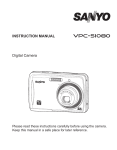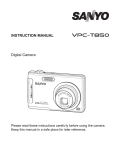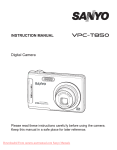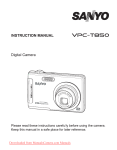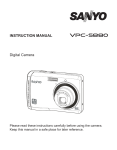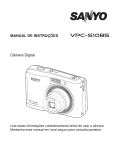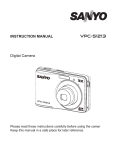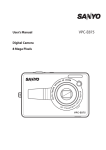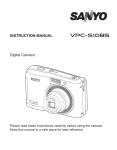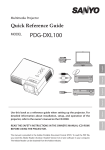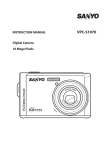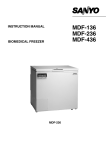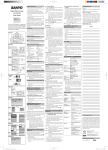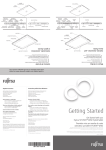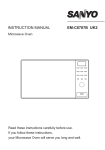Download Sanyo Xacti VPC-HD100 User's Manual
Transcript
FCC STATEMENT This device complies with Part 15 of the FCC Rules. Operation is subject to the following two conditions: (1) This device may not cause harmful interference, and (2) This device must accept any interference received, including interference that may cause undesired operation. Note: This equipment has been tested and found to comply with the limits for Class B digital devices, pursuant to Part 15 of the FCC rules. These limits are designed to provide reasonable protection against harmful interference in a residential installation.This equipment generates uses and can radiate radio frequency energy and, if not installed and used in accordance with the instructions, may cause harmful interference to radio communications. However, there is no guarantee that interference will not occur in a particular installation. If this equipment does cause harmful interference to radio or television reception, which can be determined by turning the equipment off and on, the user is encouraged to try to correct the interference by one or more of the following measures: Reorient or relocate the receiving antenna. Increase the separation between the equipment and receiver. Connect the equipment into an outlet on a circuit different from that to which the receiver is connected. Consult the dealer or an experienced radio/TV technician for help. Use of shielded cable is required to comply with Class B limits in Subpart B of Part 15 of the FCC rules. Do not make any changes or modifications to the equipment unless otherwise specified in the manual. If such changes or modifications should be made, you could be required to stop operation of the equipment. Notice If static electricity or electromagnetism causes data transfer to discontinue midway (fail), restart the application or disconnect and connect the communication cable (USB, etc.) again. EN-1 READ THIS FIRST Trademark Information Microsoft® and Windows® are U.S. registered trademarks of Microsoft Corporation. Pentium® is a registered trademark of Intel Corporation. Macintosh is a trademark of Apple Inc. SD™ is a trademark. SDHC™ is a trademark. Other names and products may be trademarks or registered trademarks of their respective owners. Product Information Product design and specifications are subject to change without notice. This includes primary product specifications, software, software drivers, and user’s manual. This User Manual is a general reference guide for the product. The product and accessories that come with your camera may be different from those described in this manual. This is due to the fact that different retailers often specify slightly different product inclusions and accessories to suit their market requirements, customer demographics, and geographical preferences. Products very often vary between retailers especially with accessories such as batteries, chargers, AC adapters, memory cards, cables, pouches, and language support. Occasionally a retailer will specify a unique product color, appearance, and internal memory capacity. Contact your dealer for precise product definition and included accessories. The illustrations in this manual are for the purpose of explanation and may differ from the actual design of your camera. The manufacturer assumes no liability for any errors or discrepancies in this user manual. EN-2 SAFETY INSTRUCTIONS Read and understand all Warnings and Cautions before using this product. Warnings If foreign objects or water have entered the camera, turn the power off and remove the battery. Continued use might cause fire or electric shock. Consult the store of purchase. If the camera has fallen or its case has been damaged, turn the power off and remove the battery. Continued use might cause fire or electric shock. Consult the store of purchase. Do not disassemble, change or repair the camera. This might cause fire or electric shock. For repair or internal inspection, ask the store of purchase. Do not use the camera in areas near water. This might cause fire or electric shock. Take special care during rain, snow, on the beach, or near the shore. Do not place the camera on inclined or unstable surfaces. This might cause the camera to fall or tilt over, causing damage. Keep the battery out of the reach of children. Swallowing the battery might cause poisoning. If the battery is accidentally swallowed, immediately consult a physician. Do not use the camera while you are walking, driving or riding a motorcycle. This might cause you to fall over or result in traffic accident. EN-3 Cautions Insert the battery paying careful attention to the polarity (+ or –) of the terminals. Inserting the battery with its polarities inverted might cause fire and injury, or damage to the surrounding areas due to the battery rupturing or leaking. Do not fire the flash close to anyone’s eyes. This might cause damage to the person’s eyesight. Do not subject the LCD monitor to impact. This might damage the glass on the screen or cause the internal fluid to leak. If the internal fluid enters your eyes or comes into contact with your body or clothes, rinse with fresh water. If the internal fluid has entered your eyes, consult a physician to receive treatment. A camera is a precision instrument. Do not drop it, strike it or use excessive force when handling the camera. This might cause damage to the camera. Do not use the camera in humid, steamy, smoky, or dusty places. This might cause fire or electric shock. Do not remove the battery immediately after long period of continuous use. The battery becomes hot during use. Touching a hot battery might cause burns. Do not wrap the camera or place it in cloth or blankets. This might cause heat to build up and deform the case, resulting in fire. Use the camera in a well-ventilated place. Do not leave the camera in places where the temperature may rise significantly, such as inside a car. This might adversely affect the case or the parts inside, resulting in fire. Before you move the camera, disconnect cords and cables. Failure to do this might damage cords and cables, resulting in fire and electric shock. EN-4 Warning: TO PREVENT THE RISK OF FIRE OR ELECTRIC SHOCK, DO NOT EXPOSE THIS APPLIANCE TO RAIN OR MOISTURE FOR AMERICAN USERS The following advisory is included in accordance with the laws of the State of California (USA): WARNING: This product contains chemicals, including lead, known to the States of California to cause cancer, birth defects or other reproductive harm. Wash hands after handling. zThis equipment has been tested and found to comply with the limits for a Class B digital device, pursuant to Part 15 of the FCC Rules. These limits are designated to provide reasonable protection against harmful interference in a residential installation. This equipment generates, uses and can radiate radio frequency energy and, if not installed and used in accordance with instructions, may cause harmful interference to radio communications. However, there is no guarantee that interference will not occur in a particular installation. If this equipment does cause harmful interference to radio or television reception, which can be determined by turning the equipment off and on, the user is encouraged to try to correct the interference by one or more of the following measures: * Reorient or relocate the receiving antenna. * Increase the separation between the equipment and receiver. * Connect the equipment into an outlet on a circuit different from that to which the receiver is connected. * Consult the dealer or an experienced radio/TV technician for help. zChanges or modifications not expressly approved by the party responsible for compliance could void the userís authority to operate the equipment. EN-5 FOR CANADIAN USERS zThis Class B digital apparatus complies with Canadian ICES-003 FOR EU USERS This symbol mark and recycling systems described below apply to EU countries and do not apply to countries in other areas of the world. Your SANYO product is designed and manufactured with high quality materials and components which can be recycled and/or reused. The symbol mark means that electrical and electronic equipment, batteries and accumulators, at their end-of-life, should be disposed of separately from your household waste. Note: If a chemical symbol is printed beneath the symbol mark, this chemical symbol means that the battery or accumulator contains a heavy metal at a certain concentration. This will be indicated as follows: Hg: mercury, Cd: cadmium, Pb: lead In the European Union there are separate collection systems for used electrical and electronic equipment, batteries and accumulators. Please, despose of them correctly at your local community waste collection/recycling centre. Please, help us to conserve the environment we live in! Manufacturer and Address SANYO Electric Co., Ltd. 5-5, Keihan-hondori, 2-chome, Moriguchi City, Osaka, Japan Authorized Representative and Address SANYO FISHER Sales (Europe) GmbH Stahlgruberring 4, D-81829 Munich, Germany EN-6 Symbols used in this manual Points giving some extended instructions or special points to pay attention to. You many find the answers to questions or problems concerning camera operation in the sections “Troubleshooting”. FCC information Tested To Comply With FCC Standards FOR HOME OR OFFICE USE Declaration of Conformity Model number: VPC-HD100 Trade Name: SANYO Responsible party: SANYO FISHER COMPANY Address: 21605 Plummer Street Chatsworth, California 91311 Telephone No.: (818) 998-7322 This device complies with Part 15 of the FCC Rules. Operation is subject to the following two conditions: (1) this device may not cause harmful interference, and (2) this device must accept any interference received, including interference that may cause undesired operation. Canadian ICES-003 information This class B digital apparatus complies with Canadian ICES-003. EN-7 Notes on Battery Usage When you use the battery, carefully read and strictly observe the Safety Instructions and the notes described below: Use only the specified battery. Avoid extremely cold environments as low temperatures can shorten the battery life and reduce camera performance. When you are using a new rechargeable battery or a rechargeable battery that has not been used for an extended period of time, it may affect the number of images that can be captured. Therefore, to maximize its performance and lifetime, we recommend that you fully charge the battery and discharge it for at least one complete cycle before use. The battery may feel warm after a long period of continuous use of the camera or the flash. This is normal and not a malfunction. The camera may feel warm after a long period of continuous use. This is normal and not a malfunction. If the battery is not to be used for a long period of time, remove it from the camera to prevent leakage or corrosion and store it after no battery power is left. Stored for a long time in a fully charged condition, its performance may be impaired. Always keep the battery terminals clean. There is a risk of explosion if the battery is replaced by an incorrect type. Dispose of used battery according to the recycle instructions. Charge the rechargeable!battery fully before using for the first time. To prevent short-circuiting or fire, keep the battery away from other metal objects when carrying or storing. CAUTION Danger of explosion if battery is incorrectly replaced. Replace only with the same or equivalent type. - SANYO Li-ion Battery, NP-61, 3.7V, 1100mAh - BYD Li-ion Battery, NP60, 3.7V, 1050mAh EN-8 CONTENTS 10 INTRODUCTION 10 Overview 10 Package Contents 12 GETTING TO KNOW YOUR DIGITAL VIDEO CAMERA 12 Front View 12 Rear View 13 LCD Monitor Display 16 GETTING STARTED 16 17 18 18 19 20 20 21 Preparation Charging the Battery Turning the Power On/Off LED Indicators Handling the Digital Video Camera Setting the Date and Time Choosing the Language Formatting the Memory Card 22 CAPTURE MODE 22 22 23 23 24 Recording Video Clips Capturing Still Images Using the Zoom Function Using the Assist Light Recording Shots using Face Detection Technology 25 Setting Manual White Balance 29 Slide Show Display 30 Protecting Images/Video Clips/ Audio Files 31 Deleting Images/Video Clips/ Audio Files 32 MP3 MODE 33 MENU OPTIONS 33 35 37 38 39 Video Menu Capture Menu Playback Menu MP3 Menu Setup Menu 41 INSTALLING SOFTWARE PROGRAM 42 TRANSFERRING FILES TO YOUR COMPUTER 42 Downloading / Deleting Your Files via Computer 43 SPECIFICATIONS 44 APPENDIX 44 Possible Number of Shots 45 Troubleshooting 26 AUDIO MODE 26 Recording Audio Files 26 Playing Back Audio Files 27 PLAYBACK MODE 27 Playing Back Video Clips 27 Playing Back Still Images 28 Playing Back Still Images/Video Clips on TV 28 Connecting the Digital Video Camera to HDTV 28 Connecting for Standard TV 29 Thumbnail Display EN-9 INTRODUCTION Overview Congratulations on your purchase of the new digital video camera. Equipped with a 5.0-megapixel sensor, this digital video camera captures still images and video clips with high definition. Package Contents Carefully unpack your digital video camera and ensure that you have the following items: Common Product Components: Digital video camera Software CD-ROM USB cable AV cable YPbPr (HD out) cable Earphone Camera strap Camera pouch Rechargeable lithium-ion battery Battery charger Quick start guide Instruction manual Common (Optional) Accessories: SD/SDHC memory card Accessories and components may vary by retailer. EN-10 GETTING TO KNOW YOUR DIGITAL VIDEO CAMERA Front View 1 2 3 7 4 5 6 1. 2. 3. 4. 5. 6. 7. Lens LED assist light Speaker Battery!cover Strap holder DC door Tripod mount EN-11 Rear View 1 2 3 4 5 6 7 8 9 10 11 12 16 13 14 15 1. Microphone 2. Status LED 3. Play button 4. S Up button MODE Mode button 5. X Right button O Focus button 6. T Down button MENU Menu!button 7. OK!/!Record!/!Shutter button 8. T Zoom in (telephoto) button EN-12 9. W Zoom out (wide-angle) button / Thumbnail button 10. W Left button Assist light button 11. Power button 12. USB or AV OUT terminal 13. HDTV terminal 14. SD/SDHC memory card slot 15. Earphone jack 16. LCD monitor LCD Monitor Display Standby Mode Video Mode 1 2 3 Camera Mode 4 13 1 5 2 16 3 4 5 6 6 7 7 8 8 9 12 11 10 9 1. Video mode icon 2. Available recording time 3. Storage media [q] SD/SDHC memory card 4. Battery condition [l] Full battery power [o] Medium battery power [n] Low battery power [m] No battery power 5. Focus setting [Blank] Normal [O] Macro [Q] Infinity 6. Assist light ON 7. Scene mode [Blank] Auto [ O ] Portrait [ C ] Night [ F ] Sports [ N ] Landscape [ K ] Sunset [ X ] Beach/Snow [ Y ] Spotlight [ N ] User Setting 8. Self-timer [e10s] 10 sec. [e2s] 2 sec. 9. Exposure compensation 10. White balance [Blank] Auto [%] Daylight [#] Cloudy [&] Fluoresc.1 [*] Fluoresc.2 [$] Tungsten [(] Manual WB 11. Image quality [y] Fine [x] Standard [w] Economy 12. Video size [ ] 1440 x 1080 [ ] 1280 x 720 [ VGA ] 640 x 480 13. Zoom status bar 15 14 13 12 11 10 1. 2. 3. 4. 5. 6. 7. 8. 9. 10. 11. 12. 13. 14. 15. 16. Camera mode icon Available number of shots Storage media Battery condition Focus setting [Blank] Normal [O] Macro [Q] Infinity [Z] Face detection Assist light ON Scene mode Image stabilization icon Self-timer Capture mode icon [Blank] Single [U] AEB [T] Continuous ISO [Blank] Auto [:] 64 [5] 100 [7] 200 [9] 400 Exposure compensation White balance Image quality Image size [7.7m] 3200 x 2400 (FW interpolation) [5m] 2560 x 1920 [3m] 2048 x 1536 [1m] 1280 x 960 [ VGA ] 640 x 480 Zoom status bar EN-13 Audio Recording Mode (Standby) 1 2 (Recording) 3 4 1 7 5 2 6 1. 2. 3. 4. 5. 6. 7. Audio mode icon Available recording time Storage media Battery condition Elapsed time Recording indicator Status indicator (standby) 1. Recording indicator 2. Status indicator (recording) Playback Mode Video Mode 1 Camera Mode 2 3 8 7 1. 2. 3. 4. 5. 6. 7. 8. 4 1 2 3 5 6 Video playback mode icon Elapsed time Storage media Battery condition Folder and file number Volume indicator Video status bar Playback indicator EN-14 4 1. 2. 3. 4. Image playback mode icon Storage media Battery condition Folder and file number Audio Playback Mode MP3 Mode 1 2 3 4 1 11 5 10 6 2 3 8 4 5 7 9 8 1. MP3 mode icon 2. Elapsed time 3. Storage media 4. Battery condition 5. Volume indicator 6. MP3 title 7. MP3 list 8. MP3 menu 9. Playback indicator 10. Play mode indicator 11. MP3 status bar 7 1. 2. 3. 4. 5. 6. 7. 8. 6 Audio playback mode icon Elapsed time Storage media Battery condition Volume indicator File name (ex. 100-0001) Playback indicator Audio status bar EN-15 GETTING STARTED Preparation 1. Attach the camera strap. 2. Open the battery cover. 3. Insert the supplied battery with correct orientation as shown. Close the battery cover and make sure it is locked securely. 4. Insert an SD/SDHC memory card. The digital video camera does not have built-in memory and cannot operate without an SD/SDHC memory card inserted. Make sure to insert an SD/ SDHC memory card before use. Open the SD card slot cover gently. Insert an SD/SDHC memory card (optional) to the card slot. Close the cover and make sure it is locked securely. Be sure to format the SD/SDHC memory card with this video camera before its initial usage. To prevent valuable data from being accidentally deleted from an SD/SDHC memory card, you can slide the write protect tab (on the side of the SD/SDHC memory card) to “LOCK”. To save, edit, or delete data on an SD/SDHC memory card, you must unlock the card/ To prevent damaging of SD/SDHC memory card, be sure to turn off the power when inserting or removing the SD/SDHC memory card. If inserting or removing the SD/SDHC memory card with the power on, the digital video camera will automatically turn off. Be careful not to drop the batteries when opening or closing the battery cover. EN-16 Charging the Battery Charge the battery fully with the supplied battery charger before use. 1. Insert the battery into the battery charger. 2. Connect the power cord to the charger and insert the plug into a wall outlet. The status LED on the charger lights red when charging has started and lights 2 green when charging is completed. The LED also lights green if no battery is inserted into the charger. Charging time varies according to the ambient temperature and the status of battery. Remove the battery after charging is completed. 1 The battery may feel warm after it has been charged or immediately after being used. This is normal and not a malfunction. When using the camera in cold areas, keep the camera and battery warm by holding them inside your outer clothes. EN-17 Turning the Power On/Off Load the battery and insert an SD/SDHC memory card before starting. Press the button until the digital video camera turns on. To turn the power off, press the button again. The power is turned off automatically when the digital video camera has not been operated for a defined period of time. To resume operation, turn the power on again. Refer to section in this manual titled “Auto Off” in the setup menu for further details. LED Indicators Indicators State Description/Activity Status LED Solid green The digital video camera is powering up. Status LED Solid green The digital video!camera is ready to record! images (or videos). Status LED Blinking green USB communication/transfer is in progress. Status LED Blinking green Reading/Writing files. EN-18 Handling the Digital Video Camera 1. Open the panel by pulling it away from the digital video camera. 2. Choose the angle of the monitor that suits you best by rotating the panel. The panel rotates up to 270°. It is useful for self-portrait. Make sure you open the LCD panel at 90 degrees before attempting to rotate it. Rotate the LCD panel carefully with the correct direction. Over rotation or rotating to the wrong direction may damage the hinge that connects the LCD monitor to the digital video camera. Avoid touching the LCD monitor when moving the LCD panel. Cautions: Do not hold the digital video camera by only holding the LCD panel. Be careful not to block the lens, microphone, or LED lights with your fingers when shooting. Close the LCD panel when not using the digital video camera to avoid damages. EN-19 Setting the Date and Time The date/time needs to be set if/when: The digital video camera is turned on for the first time. The digital video camera is turned on after being left without battery for an extended period of time. 1. Press the button until the digital video camera turns on. 2. Press the MENU button. 3. Select [Setup] with the f (O) button. 4. Select [Date/Time] with the c (MODE) / d (MENU) buttons, and press the button. Select the item’s field with the e ( )/f (O) buttons and adjust the value for the date and time with the c (MODE) / d (MENU) buttons. The time is displayed in 24-hour format. After confirming all settings are correct, press the button. 5. To exit from the [Setup] menu, press the f (O) button. Setup Language Beep English On Format LCD Bright. Date/Time Next Menu 0 Next Menu : Exit : OK Date / Time 2008.01.01 00:00 Y/M/D : OK Choosing the Language Specify in which language menus and messages are to be displayed on the LCD monitor. 1. Press the MENU button. 2. Select [Setup] menu with the f (O) button. 3. Select [Language] with the c (MODE) / d (MENU) buttons, and press the button. 4. Select the displayed language with the c (MODE) / d (MENU) buttons, and press the button. The setting will be stored. EN-20 Setup Language Beep English On Format LCD Bright. Date/Time Next Menu 0 : Exit Next Menu : OK Formatting the Memory Card This utility formats the SD/SDHC memory card and deletes all stored images, video clips, and data. 1. Press the MENU button. 2. Select [Setup] menu with the f (O) button. 3. Select [Format] with the c (MODE) / d (MENU) buttons, and press the button. 4. Select [Yes] with the c (MODE) / d (MENU) buttons, and press the button. To cancel formatting, select [No] and press the button. 5. To exit from the [Setup] menu, press the f (O) button. Setup English Language Beep On Format LCD Bright. Date/Time Next Menu 0 Next Menu : Exit : OK Format Format Card? No Yes : Exit : OK EN-21 CAPTURE MODE Your digital video camera is equipped with a 2.5" full color LTPS LCD monitor to help you capture/playback images and video clips or adjust menu settings. Recording Video Clips 1. Press the button until the digital video camera turns on. The default mode is Video Mode. 2. Compose the image on the LCD monitor. 3. Press the button to start recording. 4. To stop recording, press the button. The recording time depends on the storage media size and the subject to be recorded. If the acess speed of your SD/SDHC memory card is not fast enough for recording video clips in the currently selected size, the recording will stop. In this case, select a video quality lower than the current one. When using SDHC memory card to record high resolution video clips, higher than Class 4 is recommended to prevent recording from discontinuing. Capturing Still Images 1. Press the button until the digital video camera turns on. 2. Press the MODE button to switch to capture mode. 3. Compose the image on the LCD monitor. 4. Press the button to capture the image. EN-22 Using the Zoom Function Using a combination of 5x optical zoom and 4x digital zoom permits zoom photography at up to 20x magnification. While the digital zoom can be a useful feature, the more an image is enlarged (zoomed), the more pixelated (grainier) the image will appear. To capture a zoomed image/video clip, perform the following steps: 1. Compose the image on the LCD monitor. Press the T button to zoom in on the subject, and enlarge the subject on the LCD monitor. Press the W button to view a wider angle of the image. The status of digital magnification is displayed on the zoom status bar. At 1440 x 1080 (video mode): the preview can reach digital zoom to 2x. At 1280 x 720 and 640 x 480 (video mode): the preview can reach digital zoom to 4x. 2. Press the button to capture/record the image/video clip. To activate digital zoom function, set [Digi. Zoom] to [On] in the capture or video menu. Using the Assist Light When capturing still images/video clips in dark places, you can turn on the LED assist light in front of the digital video camera to help brightening and focusing on the subject. 1. In video/capture mode, press the turn the LED assist light on or off. button to The assist light can only be activated in capture or video mode. When the digital video camera is switched to playback, audio or MP3 mode, the assist light will turn off automatically. EN-23 Recording Shots using Face Detection Technology Face Detection Technology can identify and focus on the human faces in the image. This advanced function simultaneously detects up to 9 human faces regardless of their position in the scene. White frame Face detection function is on Green frame Focus lock Out of focus 1. In capture mode, toggle O button until [Z] icon appears on the LCD monitor. The white frame is identified as the “top priority” face (main focus frame), and gray ones around the other faces. 2. Press the button halfway down to lock the focus. The main focus frame simultaneously turns green. If the “top priority” face is out of focus, all frames will be disappeared from the screen. 3. Press the button down fully to capture your image. Subjects that are not suitable with this function: a. A person is wearing glasses, sunglasses, or face is covered with hat or hair. b. A person turns sideways. EN-24 Setting Manual White Balance You can manually set and store the white balance when the menu options do not offer a good match. 1. In video/capture mode, press the MENU button. 2. Select [W.Balance] with the c (MODE) / d (MENU) buttons, and press the button. 3. Select [Manual WB] with the c (MODE) / d (MENU) buttons, and press the button. 4. Select [New WB], and press the button. To use the previously set white balance data, select [Use Data], and press the button. 5. Point the video camera at a white paper or white slate, and press the button. When the manual white balance is stored, [COMPLETE] will be displayed and the video camera returns to recording mode. Manual WB Use Data New WB : Exit : OK New WB : Exit : OK EN-25 AUDIO MODE Recording Audio Files The digital video camera enables you to record and playback audio files anytime and anywhere. 1. Press the MODE button to switch to audio mode. 2. Press the button to start audio recording. To stop recording, press the button. Playing Back Audio Files 1. Press the button. 2. Select the desired audio clip with the e ( )/f (O) buttons. 3. Press the button to begin playback. To pause, press the button again. To stop playback, press the d (MENU) button. To adjust the volume, use the W/T buttons. EN-26 PLAYBACK MODE You can play back all the recorded files on the LCD monitor. Playing Back Video Clips 1. Press the button. The last recorded file appears on the LCD monitor. 2. Select the desired video clip with the e ( )/ f (O) buttons. 3. Press the button to start video playback. To pause video playback, press the button. To cancel pause, press the button again. To adjust the volume, use the W/T buttons. 4. To stop video playback, press the d (MENU) button and return to the start of the video clip. Video clips cannot be displayed rotated or enlarged. To play the video clip back on your computer, you may use Windows Media Player 9 above version. Windows Vista user may use Windows Movie Maker. Playing Back Still Images 1. Press the button. The last recorded file appears on the LCD monitor. 2. Select the desired image with the e ( )/f (O) buttons. 3. Press the T button to adjust the zoom ratio. The magnification factor is displayed on the LCD monitor. 4. To view different portion of the images, press the c (MODE) / d (MENU) / e ( ) / f (O) buttons to adjust the display area. The magnification factors range from 1.5x to 8.0x. EN-27 Playing Back Still Images/Video Clips on TV You can also playback your images on a TV screen. Before connecting to any devices, make sure to select NTSC / PAL system to match the video input system of the TV/video equipment you are going to connect to the digital video camera, then turn all connected devices off. 1. Connect one end of the AV cable to the AV OUT terminal of the digital video camera. 2. Connect the other end to the AV input socket of the TV set. 3. Turn the TV and digital video camera on. 4. Playback the still images/video clips. 5. The method of operation is the same as playing back still images and video clips!on the digital video camera. Connecting the Digital Video Camera to HDTV HD TV (High Definition Television) is a digital television broadcasting system with!better resolution than traditional television systems. It can perform HD (720P) high!resolution quality. HD TV Video IN (green) (green) (blue) (blue) (red) (red) (red) (white) Audio IN A/V OUT <AV cable> COMPONENT (HD OUT) (white) (yellow)(no connection) <YPbPr(HD out) cable> 1. Connect one end of the YPbPr (HD out) cable into the (Video IN) port on the HDTV!and the other end into the HDTV terminal of the digital video camera. 2. Connect one end of the AV cable into the (Audio IN) socket of the HDTV and the other end into the AV OUT terminal of the digital video camera. (Do not connect the yellow connector to HDTV’s AV-IN.) 3. Turn the TV and digital video camera on. The video camera will auto detect and set the settings when the cables are connected. Connecting for Standard TV (white) (red) Audio - IN (white) (yellow) Video - IN (yellow) EN-28 Thumbnail Display This function allows you to view thumbnail images on the LCD monitor so you may search for a particular image/video clip/audio file. 1. In playback mode, press the W button. 3 thumbnail images are displayed simultaneously. 2. Use the c (MODE) / d (MENU) buttons to select the file to be displayed. Use the e ( ) / f (O) buttons to go to previous or next page. 3. Press the button to display the selected image on full screen. Slide Show Display The slideshow function enables you to play back your still images automatically in sequential order as a slideshow. This is a very useful and entertaining feature for reviewing captured images and for presentations. 1. In the playback mode, press the MENU button. 2. Select [Slide Show] with the c (MODE) / d (MENU) buttons and press the button. 3. Select the desired interval time with the c (MODE) / d (MENU) buttons, and press the button. The slide show starts. To stop the slideshow during playback, press the button. Play Delete File Delete All Slide Show Protect : Exit No 5 Sec. 7 Sec. 9 Sec. : OK Video clips are displayed as images and will not be played back. Audio files are not displayed in slide show. EN-29 Protecting Images/Video Clips/Audio Files Set the data to read-only to prevent files from being deleted by mistake. Protecting One File 1. Press the button. 2. Select the file you wish to protect with the e( ) / f (O) buttons. 3. Press the MENU button. 4. Select [Protect] with the c (MODE) / d (MENU) buttons and press the button. 5. Select [Single] with the c (MODE) / d (MENU) buttons, and press the button. The selected file is protected. To cancel protection, perform step 1 to 5 again. Play Delete File No Delete All Slide Show Next Menu Protect : Exit Single All : OK Protecting All Files 1. Select [All] from the Protect menu and press the button. 2. Select [Lock] with the c (MODE) / d (MENU) buttons, and press the button. All stored files are protected. To cancel all protection, perform the above steps and select [Unlock] in step 2. To cancel protection for one specific file, perform above step 1 to 5 of "Protecting One File". The protect icon A is displayed with protected files. Formatting an SD/SDHC memory card overrides protection, and deletes all files regardless of their protected status. EN-30 Deleting Images/Video Clips/Audio Files 1. Press the button. 2. Select the file you wish to delete with the e( ) / f (O) buttons. 3. Press the MENU button. 4. Select [Delete File] or [Delete All] with the c (MODE) / d (MENU) buttons and press the button. [Delete File]: Deletes the current file. [Delete All]: Deletes all files. 5. Select [Yes] to delete. Select [No] to cancel. 6. Press the button to confirm. Play Delete File Delete All Slide Show Protect : Exit No Yes 5 Sec. Single : OK EN-31 MP3 MODE The digital video camera enables you to playback MP3 files. You may download MP3 files to your computer and then copy them into an SD/SDHC memory card (into an "MP3" folder). Insert an SD/SDHC memory card with MP3 files recorded into the digital video camera. 1. Press the MODE button to switch to MP3 mode. 2. Press the W button to enter the MP3 List and select the MP3 file you wish to playback. Press the button to confirm. 3. Press the button to begin playback. To pause, press the button again. To adjust the volume, use the W/T buttons. 4. To stop playback, press the d (MENU) button. To delete MP3 files, connect the digital video camera to your computer. Select and delete the files via the computer. For further information, please refer to the section in this manual titled “Downloading / Deleting Your Files via Computer” (page 42). EN-32 MENU OPTIONS Video Menu This menu is for the basic settings to be used when shooting video clips. Video Scene Self-timer Video Auto W.Balance Digi. Zoom Off Size Quality EV 1280 x 720 Standard : Exit : OK 0 Metering Color Contrast Video Auto Sharpness Standard Off Center Standard Standard : Exit : OK : Exit : OK 1. The default mode is Video Mode. 2. Press the MENU button. 3. Select the desired option item with the c (MODE) / d (MENU) buttons, and press the button to enter its respective menu. 4. Select the desired setting with the c (MODE) / d (MENU) buttons, and press the button. 5. To exit from the menu, press the e ( ) button. Scene Select from 9 different scene modes in accordance with the shooting conditions. * [Blank] Auto * [ O ] Portrait * [ C ] Night * [ F ] Sports * [ N ] Landscape * [ K ] Sunset * [ X ] Beach/Snow * [ Y ] Spotlight * [ N ] User Setting Self-timer This activates the self-timer and sets the delay time. * [Blank] Off * [e2s] 2 Sec. * [e10s] 10 Sec. Size This sets the size of the video clips that will be captured. *[ ] 1440 x 1080 *[ ] 1280 x 720 * [VGA] 640 x 480 Quality This sets the quality (compression) at which the video clips is captured. * [y] Fine * [x] Standard * [w] Economy EN-33 EV Your digital video camera adjusts the exposure of each shot automatically. However, if the subject is very dark, or very bright, you may override the digital video camera's automatic exposure determination to make the subject brighter or darker. This is called EV compensation. The EV compensation can be adjusted from -1.8EV to +1.8EV. W.Balance This sets the white balance for a variety of lighting conditions and permits images to be captured that approach the conditions that are seen by the human eye. * [Blank] Auto * [%] Daylight * [#] Cloudy * [&] Fluoresc.1 * [*] Fluoresc.2 * [$] Tungsten * [(] Manual WB Digi. Zoom This sets whether or not to use digital zoom at the time of photography. * On / Off Metering This sets the metering method for calculating the exposure. * Center: Averages the light metered from the entire frame, but gives greater weight to the subject matter in the center. * Spot: A very small portion of the center of the screen is measured, and the exposure is calculated. Color This sets the color of the video clips that will be captured. * Standard / Vivid / B&W / Sepia Contrast This sets the degree of difference between light and dark in video clips that will be captured. * Standard / Hard / Soft Sharpness This sets the sharpness of the video clips that will be captured. * Standard / Hard / Soft EN-34 Capture Menu This menu is for the basic settings to be used when capturing still images. Capture Capture Capture Scene Self-timer Auto Off W.Balance Digi. Zoom Auto Off Metering Color Center Standard Size Quality EV 5M Standard ISO Capture Md. Image Stab. Auto Single Contrast Standard Sharpness Standard : Exit 0 : OK : Exit Off : OK : Exit : OK 1. Press the MODE button to switch to capture mode. 2. Press the MENU button. 3. Select the desired option item with the c (MODE) / d (MENU) buttons, and press the button to enter its respective menu. 4. Select the desired setting with the c (MODE) / d (MENU) buttons, and press the button. 5. To exit from the menu, press the e ( ) button. Scene Refer to the section in this manual titled “Scene” in Video Menu (page 33) for further details. Self-timer Refer to the section in this manual titled “Self-timer” in Video Menu (page 33) for further details. Size This sets the size of the images that will be captured. * [7.7m] 3200 x 2400 (FW interpolation) * [5m] 2560 x 1920 * [3m] 2048 x 1536 * [1m] 1280 x 960 * [VGA] 640 x 480 Quality Refer to the section in this manual titled “Quality” in Video Menu (page 33) for further details. EV Refer to the section in this manual titled “EV” in Video Menu (page 34) for further details. W.Balance Refer to the section in this manual titled “W.Balance” in Video Menu (page 34) for further details. EN-35 Digi. Zoom Refer to the section in this manual titled “Digi. Zoom” in Video Menu (page 34) for further details. ISO This sets the sensitivity for capturing images. When the sensitivity is raised (and the ISO figure is increased), photography will become possible even in dark locations, but the more pixelated (grainier) the image will appear. * [Blank] Auto * [:] 64 * [5] 100 * [7] 200 * [9] 400 Capture Md. This sets the shooting mode for capturing still images. * [Blank] Single: Captures a single image. * [U] AEB: Auto exposure bracketing capture mode. * [T] Continuous: Captures 3 images continuously. Image Stab. This sets whether or not to use image stabilization at the time of photography. This function minimizes the influences of hand shaking when you want to capture an image. * Off / On Metering Refer to the section in this manual titled “Metering” in Video Menu (page 34) for further details. Color Refer to the section in this manual titled “Color” in Video Menu (page 34) for further details. Contrast Refer to the section in this manual titled “Contrast” in Video Menu (page 34) for further details. Sharpness Refer to the section in this manual titled “Sharpness” in Video Menu (page 34) for further details. EN-36 Playback Menu In this menu, choose which settings are to be used for still image/video clip playback. Play Delete File No Delete All Slide Show Next Menu Protect : Exit 5 Sec. Single : OK 1. Press the button. 2. Press the MENU button. 3. Select the desired option item with the c (MODE) / d (MENU) buttons, and press the button to enter its respective menu. 4. Select the desired setting with the c (MODE) / d (MENU) buttons, and press the button. 5. To exit from the menu, press the e ( ) button. Delete File Refer to section in this manual titled “Deleting Images/Video Clips/Audio Files” (page 31) for further details. Delete All Refer to section in this manual titled “Deleting Images/Video Clips/Audio Files” (page 31) for further details. Slide Show Refer to section in this manual titled “Slideshow Display” (page 29) for further details. Protect Refer to section in this manual titled “Protecting Images/Video Clips/Audio Files” (page 30) for further details. EN-37 MP3 Menu This menu is for the basic settings to be used when playing back MP3 files. MP3 Play Mode Repeat : Exit Single Off : OK 1. Press the MODE button to switch to MP3 mode. 2. Press the MENU button. 3. Select the desired option item with the c (MODE) / d (MENU) buttons, and press the button to enter its respective menu. 4. Select the desired setting with the c (MODE) / d (MENU) buttons, and press the button. 5. To exit from the menu, press the e ( ) button. Play Mode Set the playback mode of the MP3 files. * [Single]: Play a single MP3 file. * [All]: Play all MP3 files. Repeat Set the repeat mode of the MP3 files. * [Off]: Play the listed files only once. * [On]: Play the listed MP3 files repeatedly. EN-38 Setup Menu This menu sets your digital video camera’s operating environment. Setup Language Beep Format LCD Bright. Date/Time : Exit Setup English On Next Menu 0 Next Menu : OK 1 Min. Auto Off Video Out NTSC Light Freq. Sys. Reset Version 50 Hz No Next Menu : Exit : OK 1. Press the MENU button. 2. Select the [Setup] menu with the f (O) button. 3. Select the desired option item with the c (MODE) / d (MENU) buttons, and press the button to enter its respective menu. 4. Select the desired setting with the c (MODE) / d (MENU) buttons, and press the button. 5. To exit from the menu, press the f (O) button. Language Refer to section in this manual titled “Choosing the Language” (page 20) for further details. Beep This sets whether or not to mute the digital video camera sound each time you press the digital video camera's buttons. * On / Off Format Refer to section in this manual titled “Formatting the Memory Card” (page 21) for further details. LCD Bright. This sets the brightness of the LCD monitor screen. * The adjustment range is from -5 to +5. Date/Time Refer to section in this manual titled “Setting the Date and Time” (page 20) for further details. Auto Off If no operation is performed for a specific period of time, the power to the digital video camera is automatically turned off. This feature is useful to reduce battery usage. * Off / 1 Min. / 3 Min. / 5 Min. / 10 Min. EN-39 Video Out Set TV/video compatibility with the equipment you are going to connect to the digital video camera. * NTSC / PAL Light Freq. The function allows to change the light frequency of environment to 60 Hz or 50 Hz. * 50 Hz / 60 Hz Sys. Reset Return all basic settings to the digital video camera's default settings. * No / Yes Version This display the firmware version of the digital video camera. EN-40 INSTALLING SOFTWARE PROGRAM 1. Please make sure you have Windows Media Player 9 or QuickTime 7.0 installed onto your computer first. 2. Please install the decoder program (available in the CD). H.264 files may be played back with Windows Media Player 9. (Decoder is designed for H.264 decode) MP4/H.264 playback system requirements: At least 512MB of RAM 64MB or higher video card Windows 2000 Service Pack 4 or XP or Vista 32 or Vista 64 DirectX 9.0b or higher Audio format 48KHz HE-AAC or AAC Resolution fps 640!x!480 30 fps CPU requirements 2.4 GHz Intel Pentium 4 or higher 1280!x!720 30 fps 3.2 GHz Intel Pentium D(dual-core) or higher 1440!x!1080 30 fps Core 2 Duo 2.0 & 128MB independent memory for image display EN-41 TRANSFERRING FILES TO YOUR COMPUTER System Requirement Windows Macintosh Pentium III 800 MHz or equivalent Windows 2000/XP/Vista 256MB RAM (512MB recommended) 150MB available hard disk space CD-ROM drive Available USB port PowerPC G3/G4/G5 OS 9.0 or later 256MB RAM (512MB recommended) 128MB hard disk space CD-ROM drive Available USB port Downloading / Deleting Your Files via Computer 1. Press the button until the digital video camera turns on. 2. Connect one end of the USB cable (supplied) to the USB terminal of the digital video camera. 3. Connect the other end of the USB cable to an available USB port on your computer. 4. From the Windows desktop, double click on “My Computer”. 5. Look for a new “removable disk” icon. This “removable disk” is actually the memory (or memory card) in your video camera. Typically, the video camera will be assigned drive letter “E” or higher. 6. Double click on the removable disk and locate the DCIM, MP3 and AUDIO folders. 7. Double click on the respective folder to open it to find more folders. Your recorded images, video clips, audio files will be inside these folders. 8. Copy and paste or drag and drop files to a folder on your computer. Copy MP3 files from your computer into the MP3 folder of your SD/SDHC memory card. 9. To delete files, simply select the unwanted files and delete. Mac users: Double-click the “untitled” or “unlabeled” disk drive icon on your desktop. iPhoto may automatically launch. Notes on Image Printing After transferring data to a computer, it stores and displays the digital images that have been saved in the SD/SDHC memory card from the digital video camera and enables those images to be printed on a variety of digital printers. EN-42 SPECIFICATIONS Item Description Image sensor 1/2.5” CMOS sensor Effective pixels 5.0 megapixels Image resolution <Still image> 7.7M: 3200 x 2400 (FW interpolation), 5M: 2560 x 1920, 3M: 2048 x 1536, 1M: 1280 x 960, VGA: 640 x 480 <Video clip> 1440 x 1080 (30 fps), 1280 x 720 (30 fps), 640 x 480 (30 fps) Recording media Supports SD/SDHC memory card (up to 8GB) (optional) File format Image format: JPEG; Video format: H.264; Audio format: AAC Lens Aperture: F3.3 ~ F3.7 Focal Length: 6.4 ~ 32 mm Focus range Macro Wide: 10cm ~ infinity Tele: 1m ~ infinity Standard Wide: 50cm ~ infinity Tele: 1m ~ infinity Shutter speed 1 ~ 1/4000 sec. LCD monitor 2.5” full color LTPS LCD (153K pixels) Self-timer 10 sec delay, 2 sec delay Exposure compensation -1.8EV~ +1.8EV (in 0.3EV increments) White balance Auto, Daylight, Cloudy, Fluoresc.1, Fluoresc.2, Tungsten, Manual WB ISO Auto, 64, 100, 200, 400 (Standard Output Sensitivity) * Sensitivity is measured in compliance with the ISO Standard (ISO 12232:2006) Interface USB terminal, AV/OUT terminal, HDTV terminal, earphone jack Power Rechargeable Lithium-ion battery (3.7V) Dimensions Approx. 87.4 x 114.6 x 40.5 mm (without protruding parts) Weight Approx. 164g (without battery and memory card) * Design and specifications are subject to change without notice. EN-43 APPENDIX Possible Number of Shots The table shows the approximate shots/recording time that you can capture/record at each setting based on the capacity of the SD/SDHC memory card. Possible recording time / sec (video clip) SD/SDHC memory card capacity Size Quality y Fine 1440 x 1080 256MB 512MB 1GB 2GB 4GB SDHC 8GB SDHC 00:01:57 00:04:04 00:08:17 00:16:46 00:33:12 01:05:46 02:11:38 x Standard 00:02:14 00:04:39 00:09:28 00:19:08 00:37:52 01:15:00 02:30:06 w!Economy 00:02:37 00:05:26 00:11:01 00:22:17 00:44:04 01:27:14 02:54:34 y Fine 1280 x 720 128MB 00:02:37 00:05:26 00:11:01 00:22:17 00:44:04 01:27:14 02:54:34 x Standard 00:03:09 00:06:30 00:13:11 00:26:38 00:52:40 01:44:15 03:28:37 w!Economy 00:03:57 00:08:06 00:16:24 00:33:06 01:05:26 02:09:29 04:19:04 y Fine 00:05:14 00:10:44 00:21:40 00:43:42 01:26:21 02:50:50 05:41:47 VGA x Standard 00:06:15 00:12:47 00:25:48 00:52:01 01:42:44 03:23:15 06:46:37 640 x 480 w!Economy 00:07:43 00:15:47 00:31:51 01:04:12 02:06:50 04:10:56 08:22:02 Possible number of shots (still image) SD/SDHC memory card capacity Size Quality y Fine 7.7m x Standard 3200 x 2400 (FW interpolation) w!Economy 5m 2560 x 1920 3m 2048 x 1536 1m 1280 x 960 VGA 640 x 480 EN-44 y Fine x Standard w!Economy y Fine x Standard w!Economy y Fine x Standard w!Economy y Fine x Standard w!Economy 128MB 256MB 512MB 1GB 32 42 53 46 61 76 69 92 115 144 191 238 390 520 648 67 89 111 95 126 157 142 189 236 294 391 486 797 1061 1322 138 184 229 195 259 323 291 388 483 599 797 991 1625 2162 2693 278 369 460 391 519 647 582 774 965 1195 1588 1976 3239 4309 5370 2GB 4GB SDHC 8GB SDHC 545 1091 2194 725 1450 2917 903 1805 3632 767 1532 3081 1019 2036 4094 1269 2535 5098 1141 2279 4583 1517 3030 6092 1880 3774 7588 2340 4670 9387 3110 6207 12477 3869 7722 15523 6341 12654 25437 8436 16836 33844 10512 20978 42169 Troubleshooting Refer to the symptoms and solutions listed below before sending the digital video camera for repairs. If the problem persists, contact your local reseller or service center. Solutions / Corrective Symptom Cause Actions The power does not The battery is not inserted. come on. The battery is exhausted. Insert the battery correctly. Recharge the battery. The battery or video camera feels warm. Long period of continuous use of the video camera. Even if press the shutter button, the digital video does not shoot. The SD/SDHC memory card does not have any free capacity. Insert a new SD/SDHC memory card, or delete unwanted files. The video camera is not in shooting mode. Set the video camera to shooting mode. The SD/SDHC memory card is write-protected. Remove the write-protection. The lens is dirty. Wipe clean with a soft, dry cloth or lens paper. The video camera cannot focus. The distance to the subject is Place your subject within the smaller than the effective range. effective focus range. Files cannot be deleted. The file is protected. Cancel protection. The SD/SDHC memory card is write-protected. Remove the write-protection. Cannot download images. The free space on the hard Check whether the hard disk has disk in your computer may be a space for running Windows, insufficient. and if the drive for loading image files has a capacity at least that of the memory card inserted in the video camera. EN-45















































